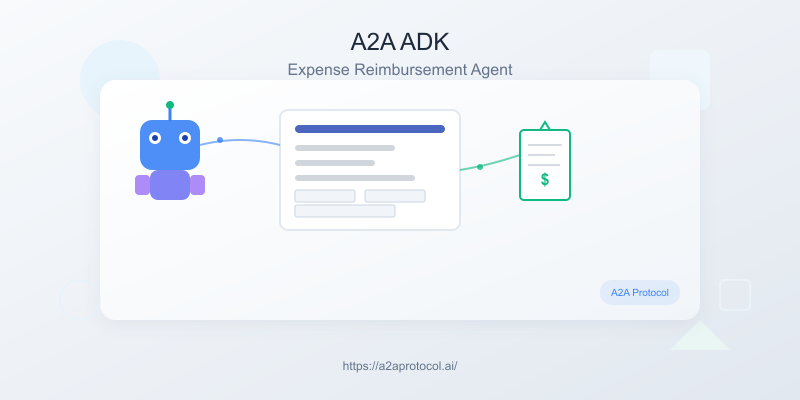
This is an intelligent expense reimbursement agent developed based on Google Agent Development Kit (ADK), running as an Agent2Agent (A2A) server. The core feature of this agent is intelligent form generation: when a user's reimbursement request lacks necessary information, the agent automatically generates a form for the user to fill out, ensuring complete reimbursement information is collected before processing.
Source Code
🎯 Project Features
- Intelligent Form Interaction: Automatically detects missing information and generates dynamic forms
- A2A Protocol Support: Standardized inter-agent communication protocol
- Streaming Processing: Supports real-time responses and status updates
- Google ADK Integration: Based on Google's latest Agent Development Kit
📋 System Requirements
- Python 3.12 or higher
- UV package management tool
- Google API Key (Gemini model access)
🚀 Quick Start
1. Get Google API Key
- Visit Google AI Studio
- Log in to your Google account
- Click "Get API key"
- Create a new API key or use an existing one
- Copy the API key for later use
2. Environment Configuration
# Clone the project locally (if needed)
git clone https://github.com/sing1ee/a2a-adk-expense-reimbursement.git
cd a2a-adk-expense-reimbursement
# Create environment variable file
echo "GOOGLE_API_KEY=your_api_key_here" > .env
# Replace your_api_key_here with your actual API key
3. Install Dependencies and Run
# Activate virtual environment
source .venv/bin/activate
# Run the project using uv
uv run .
The server will start at http://localhost:10002.
4. Test with CLI Client
Open a new terminal window:
git clone https://github.com/a2aproject/a2a-samples.git
# Navigate to CLI client directory (assuming in samples/python/hosts/cli)
cd a2a-samples/samples/python/hosts/cli
# Connect to the reimbursement agent
uv run . --agent http://localhost:10002
5. Test Interaction Examples
Enter the following test commands in the CLI client:
# Example 1: Request with missing information (will trigger form)
I need to reimburse $20 for lunch
# Example 2: Request with complete information
I need to reimburse $50 for client lunch on January 15, 2024
# Example 3: Request with partial information
Please help me reimburse yesterday's transportation cost of $25
🏗️ Project Architecture
Core File Structure
a2a-adk-expense-reimbursement/
├── __main__.py # Server startup entry
├── agent.py # Core agent logic
├── agent_executor.py # A2A request executor
├── pyproject.toml # Project configuration and dependencies
└── README.md # Project documentation
Main Component Description
1. __main__.py - Server Entry
- Configure A2A server and agent information
- Set agent skills and capability descriptions
- Start HTTP server to listen for requests
2. agent.py - Core Agent Logic
Contains three key tool functions:
create_request_form(): Create reimbursement form templatereturn_form(): Wrap form in A2A protocol format and returnreimburse(): Execute actual reimbursement approval operation
3. agent_executor.py - Request Executor
- Handle A2A protocol requests and responses
- Manage task states (working, needs input, completed, etc.)
- Coordinate communication between agent and A2A server
🔄 Core Workflow
The following sequence diagram shows the complete interaction flow of the reimbursement agent:
sequenceDiagram
participant User as User/CLI Client
participant Server as A2A Server
participant Agent as Reimbursement Agent
participant LLM as Gemini 2.0 Flash
User->>Server: Send reimbursement request<br/>"I need to reimburse $20 for lunch"
Server->>Agent: Forward user request
Agent->>LLM: Analyze request content
LLM->>Agent: Identify missing date and other info
Agent->>Agent: Call create_request_form()
Agent->>Agent: Call return_form()
Agent->>Server: Return form structure
Server->>User: Return JSON form<br/>containing date, amount, purpose fields
User->>User: User fills out form<br/>date, amount, purpose
User->>Server: Submit completed form
Server->>Agent: Forward form data
Agent->>LLM: Validate form completeness
LLM->>Agent: Confirm information is complete
Agent->>Agent: Call reimburse(request_id)
Agent->>Server: Return approval result
Server->>User: Return final result<br/>"Reimbursement approved"
Workflow Details
- Request Reception: User sends reimbursement request through CLI client
- Intelligent Analysis: Gemini model analyzes request and identifies missing necessary information
- Form Generation: If information is incomplete, automatically generate form with required fields
- User Interaction: User fills out form to supplement missing information
- Information Validation: Validate completeness and validity of form data
- Reimbursement Processing: Execute reimbursement approval and return result
🛠️ Advanced Configuration
Environment Variables
# Google API configuration
GOOGLE_API_KEY=your_api_key_here
# Use Vertex AI (optional)
GOOGLE_GENAI_USE_VERTEXAI=TRUE
# Server configuration
HOST=localhost
PORT=10002
Run with Custom Port
uv run . --host 0.0.0.0 --port 8080
🧪 Development and Debugging
Enable Verbose Logging
The agent enables INFO level logging by default. View detailed request processing:
# View server logs
uv run . 2>&1 | tee agent.log
Form Structure Example
The agent generates forms following JSON Schema format:
{
"type": "form",
"form": {
"type": "object",
"properties": {
"date": {
"type": "string",
"format": "date",
"title": "Date",
"description": "Date of expense"
},
"amount": {
"type": "string",
"format": "number",
"title": "Amount",
"description": "Amount of expense"
},
"purpose": {
"type": "string",
"title": "Purpose",
"description": "Purpose of expense"
}
},
"required": ["date", "amount", "purpose"]
}
}
⚠️ Security Considerations
Important Notice: This sample code is for demonstration purposes only to show how the Agent2Agent (A2A) protocol works. When building production applications, any external agent must be treated as a potentially untrusted entity.
Security Measures
- Input Validation: Strictly validate and sanitize all external inputs
- Data Processing: Handle agent cards, messages, artifacts and other data with caution
- Credential Management: Implement appropriate credential protection measures
- Permission Control: Limit agent access permissions and operation scope